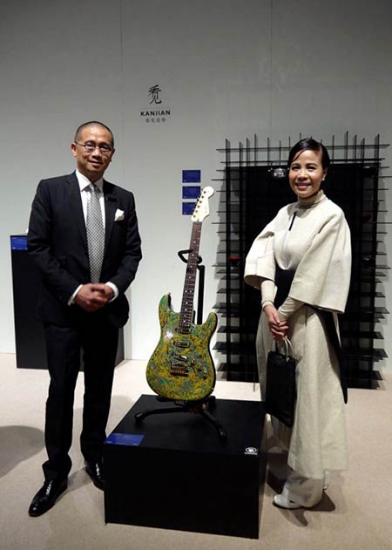
Chinese musician Zhu Zheqin, also known by her stage name Dadawa, has traveled extensively to the country's remote and border areas with a focus on preserving ethnic music and handicrafts.
The tours, which she undertook in her capacity as the United Nations Development Program Goodwill Ambassador in China in 2009, resulted in many concerts and records, where she was able to give ethnic musical elements a modern context.
But what many may not know is that the tours also led to the birth of Kanjian (which means seeing in Chinese), a design brand that Zhu established in 2012 to use contemporary design to enliven traditional Chinese crafts.
"I was not only inspired by ethnic music during the trips but also by handicrafts. I learned about paper-making and silver ware. These crafts amazed me," Zhu tells China Daily in an e-mail interview.
So, after completing her UNDP appointment, she founded Kanjian to popularize handicrafts and traditional lifestyles. This enabled designers from China and abroad to collaborate with traditional Chinese craftsmen.
Meanwhile, Zhu has produced the brand's latest product, an "azure dragon Stratocaster" electric guitar.
The instrument took nine months to make, during which time Dennis Galuszka, from the US stringed instrument manufacturer Fender, built the guitar and Zhong Sheng, a Beijing master of lacquer art, hand polished the body, giving it vivid, eye-catching lines.
It's now on display at an exhibition in international auctioneer Sotheby's Hong Kong space, together with dozens of other Kanjian products, including tea sets, vases, pottery and furniture. The display lasts until Wednesday.
"To inherit traditions doesn't mean that one should limit oneself to conventional rules. We all need new perspectives to adapt traditions to modern tastes," says Zhu.
"By blending age-old lacquer art with an electronic musical instrument, we've found a way to enrich people's lives with ancient wisdom."
Lacquer art master Zhong tells China Daily that he is always thinking about how to link traditional handicrafts with the reality of people's lives today, and that he found Kanjian a good platform where he can make a contribution.
"Traditional crafts encapsulate unspeakable beauty. It is difficult to let go of them.
"People recognize their attachment to this heritage because it is deeply rooted in our DNA, just like how we reunite with our families during the Spring Festival," says Zhong.
Among the exhibits at Sotheby's are also a couple of red-and-white cell vases that feature the qiasi skills of Jingtailan artisans from Beijing. Here, silver wires are affixed to the vase to form numerous cells, giving the vases a graceful, yet simple and modern feel, says Zhu.
Isaure de Viel Castel, Sotheby's head of Boundless Sales department, says they are very impressed by Zhu's dedication to enlivening Chinese craft traditions, and the works on show are "all conceived with a great attention to details and to the selection of materials".
Speaking of how she integrates ancient skills with modern products, Zhu says acclaimed artists such as Michael Young and Jeff Shi were part of a design team who traveled with her to Suzhou in Jiangsu province and Hangzhou in Zhejiang province in 2013, which have been centers of handicrafts since the Song Dynasty (960-1279).
There the artists, who are themselves established designers, who were so impressed by the local craftsmen that they created impressive works that bridged the past and the present.
She then took their works to Milan Design Week in 2014, hoping to raise awareness of the originality and quality of Chinese design.
The brand now works with 50 designers and traditional craftsmen. And her designers also regularly travel to Southwest China and the provinces of Jiangsu and Zhejiang, studying handicraft techniques and making the case to rejuvenate them where they are dying.
She says a 10th of the brand's profits go to a "one plus five" cultural inheritance project, which finances the costs of a handicraft master training five young apprentices.
Separately, Zhu has also launched a subsidiary brand that aims to bring affordable designs into the lives of ordinary people so that more handicraft traditions can get a chance to survive the onslaught of modernity.
British designer Tom Dixon says he collaborates with Kanjian because he hopes the success of the brand can benefit local crafts.
"It is now the best time for 'created in China'. The country can be a new source of original design," he says.
"It is only a question of time. It will arrive soon."


















































